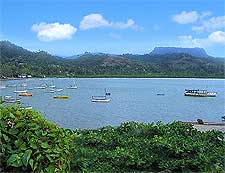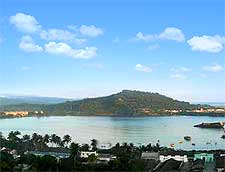Baracoa History Facts and Timeline
(Baracoa, Guantánamo, Cuba)

An important outpost in Cuban history, Baracoa is an intriguing small city in the east of the island. It is noted as the place where Columbus dropped anchor and was also the original Cuban capital. A cute cathedral, old forts and quaint houses, as well as the quirky Taino folk, are all historical highlights.
Columbus Landing
When Christopher Columbus arrived here in 1492, Baracoa was said to be the landing site and was known as Porto Santo. Columbus described a nearby mountain, which was probably El Yunque, a major landmark here. He was struck by the beauty of the island and laid a cross in the sand at the present-day harbour.
Descendants of Cuba's original inhabitants, the Taino, still reside in the area, despite being virtually eradicated by the Spanish. Hatuey, a local hero and Taino chief, garnered an army to fight the Spanish before being burned at the stake in 1512. A bust to Hatuey can be seen opposite the cathedral at the Plaza Independencia.
The Official Founding
Baracoa, historically, was founded on 15th August, 1511. Governor Diego Velázquez de Cuéllar settled here in his villa - the Nuestra Senora de la Asuncion de Baracoa, and it became capital of Cuba soon after, in 1518. The Cathedral of Our Senora of the Asuncion (Catedral de Nuestra Senora de la Asuncion) was built around this time and famously contains the cross of Columbus.
The new city grew steadily, although it became increasingly apparent in the 16th, and especially the 17th century, that Baracoa's remote location on the east of Cuba left it open to attack by pirates and illegal trading with the English and French. As a result, the Spanish eventually built several forts towards the end of the 1700s, including the Matachin Fort (Fuerte Matachin) - home to the present-day Municipal Museum, as well as the Punta Fort (Fuerte de la Punta) and the Sanguily Fort (El Castillo de Seboruco).

Franco Cocoa and Independence
Many French started to arrive in Baracoa in the early 1800s, escaping from revolt in nearby Haiti, and they cultivated cocoa and coffee in the surrounding hills for a time. By the mid-1800s, swathes of independence fighters came to Baracoa in order to further the drive for an independent Cuba, which was achieved in 1902. They included one Jose Marti - a hero of Fidel Castro's, returning from exile in the USA.
In 1949, Baracoa was declared a national monument, for its important place in the history of Cuba and its heritage sites. Even at this time, the only way to Baracoa was by sea and it wasn't until the 1960s that a road was laid from Guantánamo. Known as La Farola, the 120-km / 75-mile long road traverses mountains and bridges.
The City of Today
People mostly come to Baracoa to see the forts, the picturesque houses, and for the nearby El Yunque mountain, which can be ascended by bicycle from the city - the views from the top are fantastic. Tourists also come for the pre-Columbian archaeological sites around Baracoa, harking back to the native Indian tribes of Cuba.
Nowadays, the city is relaxing and quieter than the other main tourist places on the island of Cuba. You can learn more about Baracoa history at the Municipal Museum (Museo Municipal). This castle-cum-museum details the city's founding and its interesting growth.
 An important outpost in Cuban history, Baracoa is an intriguing small city in the east of the island. It is noted as the place where Columbus dropped anchor and was also the original Cuban capital. A cute cathedral, old forts and quaint houses, as well as the quirky Taino folk, are all historical highlights.
An important outpost in Cuban history, Baracoa is an intriguing small city in the east of the island. It is noted as the place where Columbus dropped anchor and was also the original Cuban capital. A cute cathedral, old forts and quaint houses, as well as the quirky Taino folk, are all historical highlights.